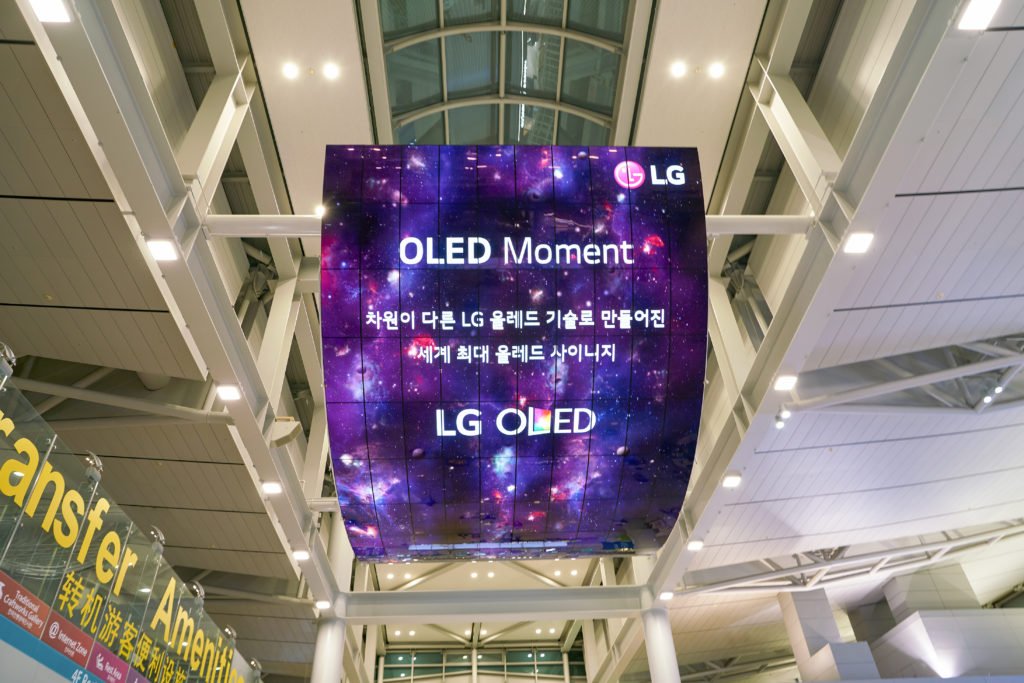
While OLED is renowned for its amazing technology and usage in many products, it’s been limited when it comes to breaking into the ever-saturated television market.
However, this technology has been making waves in the world of digital signage.
Due to its physical attributes, OLED technology has become the clear front runner due to its ability to merge its significantly enhanced picture quality with innovative display potential, which is designed to appeal to the consumer.
But how much do you know about OLED, the advancements that are happening, and how this could help improve businesses? Let’s take a look.
The peak of picture quality, OLED stands for ‘organic light-emitting diode.’
For those of you out there that are unaware of what this means, a light-emitting diode is a light source that’s used widely within the world of electronics.
As these are used in all electronics, they may sound similar to LEDs. But there are some differences. The main difference being the organic part.
Within the organic diode, you’ll find a thin film of organic compound. This is what emits light when you pass an electronic current through it.
The other difference is, OLEDs, unlike LEDs are extremely thin, making them highly flexible and even rollable.
But how do they work within the technology?
These organic diodes are taken by manufacturers and placed between two electrodes. This is what provides the current.
One of the two electrodes used will be transparent, allowing the light that’s being generated to escape. This can then be viewed by you in products ranging from wearable tech and smartphones to television screens.
When looked at further, the organic compounds used within OLED displays include carbon, alongside other ingredients, which help them to make colours. Interestingly, each colour within the screen has a different mixture of carbon and elements.
Because they are so small, millions of these then sit within your screen. These then act as individual pixels, lighting up and shutting off independently.
This is what makes them different. Because of the flexibility, when the OLED pixel shuts off, it is completely off.
This is because they are emissive displays that don’t require a backlight, like LEDs, which still emit some light when turned off due to the required backlighting.
It’s this difference (the lack of backlight) that has allowed for much better image quality when compared to LCD and plasma screens, while also providing much more flexible and thinner screens.
But, there’s something new in the world of OLED technology, which could shake up the world of digital signage – transparent OLED screens.
This new advancement is extremely exciting for those looking to provide new and stimulating displays to consumers.
Providing dynamic and interactive content via a transparent surface, these allow consumers the opportunity to see what’s on the screen, while also being able to see through it.
These transparent OLED screens will allow for much more exciting digital displays, as designers will be able to overlay images, text and video over real-life objects sitting behind the screen.
Featuring self-lighting pixels, which maintain accurate and vivid colours even when the display is transparent, these bring a whole new dimension to the merchandising process. Not to mention new and exciting ways to communicate with your audience.
That’s the best thing about these screens – they can be used almost anywhere.
Helping to transform spaces into show-stopping digital environments, these are the innovative digital screens businesses have been looking for. And, due to their slim and flexible designs, they can be placed almost anywhere too.
For example, a hair salon in Seoul introduced OLED technology display screens as mirrors. These were placed in front of customers so they could be consulted on what hairstyles and colours they’d like while being able to see them there and then within the mirror.
Garry Wicka, U.S. vice president of marketing for LG Business Solutions said:
“Just think about the possibilities in hospitality, retail and other environments where business owners are looking to create a truly one-of-a-kind experience.
“We’re combining the uniqueness of a see-through display with the unrivalled form factor and picture quality of LG OLED technology.”
As mentioned, this technology can be found within TV screens, which is helping to revolutionise the way the digital signage market operates. Especially with the introduction of transparent OLED technology.
But, in terms of sizing it’s also highly varied.
From screens as small as mobile phones to 55-inch ones, which come in both portrait and landscape mode, and not forgetting the more flexible and curved options – these are truly diverse.
You’ll even find interactive screens that were demonstrated by LG, which allow users to interact with on-screen content.
If you feel that an LG OLED signage display, in whatever shape or size is right for your business, why don’t you get in touch and see how we can help today.